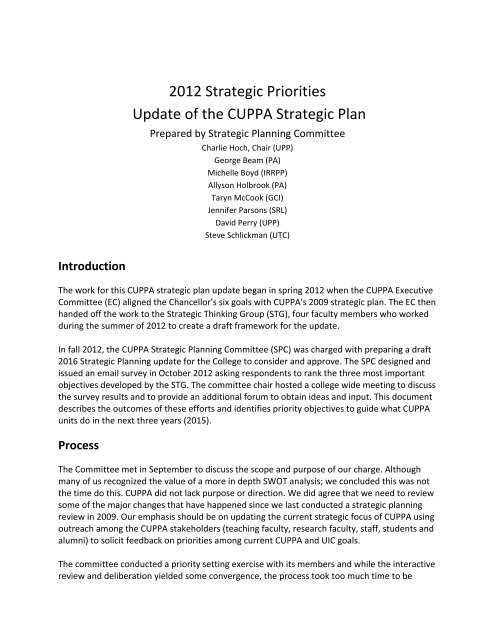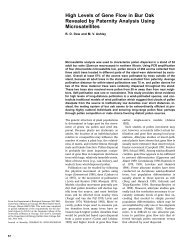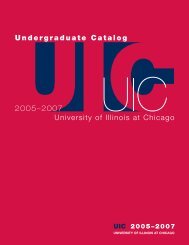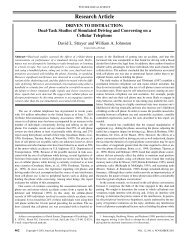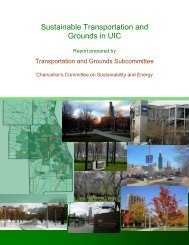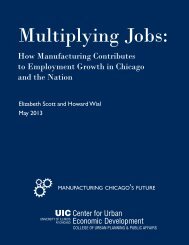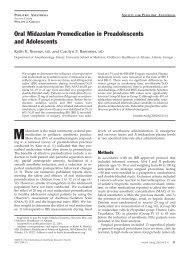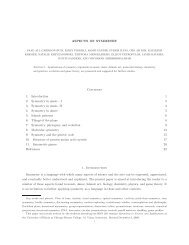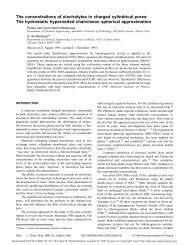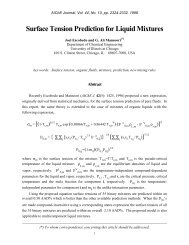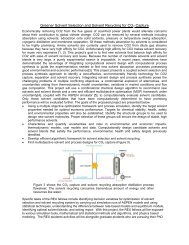CUPPA Strategic Plan - University of Illinois at Chicago
CUPPA Strategic Plan - University of Illinois at Chicago
CUPPA Strategic Plan - University of Illinois at Chicago
Create successful ePaper yourself
Turn your PDF publications into a flip-book with our unique Google optimized e-Paper software.
2012 <strong>Str<strong>at</strong>egic</strong> Priorities<br />
Upd<strong>at</strong>e <strong>of</strong> the <strong>CUPPA</strong> <strong>Str<strong>at</strong>egic</strong> <strong>Plan</strong><br />
Prepared by <strong>Str<strong>at</strong>egic</strong> <strong>Plan</strong>ning Committee<br />
Charlie Hoch, Chair (UPP)<br />
George Beam (PA)<br />
Michelle Boyd (IRRPP)<br />
Allyson Holbrook (PA)<br />
Taryn McCook (GCI)<br />
Jennifer Parsons (SRL)<br />
David Perry (UPP)<br />
Steve Schlickman (UTC)<br />
Introduction<br />
The work for this <strong>CUPPA</strong> str<strong>at</strong>egic plan upd<strong>at</strong>e began in spring 2012 when the <strong>CUPPA</strong> Executive<br />
Committee (EC) aligned the Chancellor's six goals with <strong>CUPPA</strong>'s 2009 str<strong>at</strong>egic plan. The EC then<br />
handed <strong>of</strong>f the work to the <strong>Str<strong>at</strong>egic</strong> Thinking Group (STG), four faculty members who worked<br />
during the summer <strong>of</strong> 2012 to cre<strong>at</strong>e a draft framework for the upd<strong>at</strong>e.<br />
In fall 2012, the <strong>CUPPA</strong> <strong>Str<strong>at</strong>egic</strong> <strong>Plan</strong>ning Committee (SPC) was charged with preparing a draft<br />
2016 <strong>Str<strong>at</strong>egic</strong> <strong>Plan</strong>ning upd<strong>at</strong>e for the College to consider and approve. The SPC designed and<br />
issued an email survey in October 2012 asking respondents to rank the three most important<br />
objectives developed by the STG. The committee chair hosted a college wide meeting to discuss<br />
the survey results and to provide an additional forum to obtain ideas and input. This document<br />
describes the outcomes <strong>of</strong> these efforts and identifies priority objectives to guide wh<strong>at</strong> <strong>CUPPA</strong><br />
units do in the next three years (2015).<br />
Process<br />
The Committee met in September to discuss the scope and purpose <strong>of</strong> our charge. Although<br />
many <strong>of</strong> us recognized the value <strong>of</strong> a more in depth SWOT analysis; we concluded this was not<br />
the time do this. <strong>CUPPA</strong> did not lack purpose or direction. We did agree th<strong>at</strong> we need to review<br />
some <strong>of</strong> the major changes th<strong>at</strong> have happened since we last conducted a str<strong>at</strong>egic planning<br />
review in 2009. Our emphasis should be on upd<strong>at</strong>ing the current str<strong>at</strong>egic focus <strong>of</strong> <strong>CUPPA</strong> using<br />
outreach among the <strong>CUPPA</strong> stakeholders (teaching faculty, research faculty, staff, students and<br />
alumni) to solicit feedback on priorities among current <strong>CUPPA</strong> and UIC goals.<br />
The committee conducted a priority setting exercise with its members and while the interactive<br />
review and deliber<strong>at</strong>ion yielded some convergence, the process took too much time to be
scaled up across the <strong>CUPPA</strong> community. After discussing a stakeholder meeting approach, a<br />
unit meeting approach and a survey the committee agreed th<strong>at</strong> a survey would work best<br />
reaching the most people in a timely fashion. The survey was designed by Allyson Holbrook and<br />
Jennifer Parsons <strong>at</strong> the Survey Research Labor<strong>at</strong>ory (SRL). Dean’s staff helped compile the<br />
sample frames <strong>of</strong> <strong>CUPPA</strong> faculty, staff, students and alumni. The survey was programmed by<br />
SRL Project Coordiantor Anne Diffenderfer and launched on October sent out by SRL in October<br />
and the results collected and analyzed in November. The results were used to prepare the<br />
<strong>Str<strong>at</strong>egic</strong> <strong>Plan</strong> Upd<strong>at</strong>e. Section I describes the overall condition facing the college and its<br />
present commitments; Section II describes the committee’s process for soliciting feedback from<br />
the College about str<strong>at</strong>egic plan priorities; and Section III describes how <strong>CUPPA</strong> units and<br />
members may transl<strong>at</strong>e objectives into more specific actions.<br />
Section I<br />
A. Current <strong>CUPPA</strong> Mission St<strong>at</strong>ement and Core Values<br />
Mission:<br />
Provide innov<strong>at</strong>ive urban planning and public management educ<strong>at</strong>ion th<strong>at</strong> puts engaged<br />
research to purposeful use <strong>at</strong> home and abroad.<br />
Core values:<br />
• Striving for academic excellence and providing inspir<strong>at</strong>ional learning experiences for our<br />
students.<br />
• Making a contribution beyond the university th<strong>at</strong> informs and empowers citizens, clients<br />
and communities in the neighborhood, city, region, st<strong>at</strong>e, n<strong>at</strong>ion and across the globe.<br />
• Respect for the unique individual contributions <strong>of</strong> faculty to scholarship, students to<br />
learning, and staff to service with a concern for each member's intellectual and<br />
pr<strong>of</strong>essional development.<br />
• Encouraging cultural diversity in the composition <strong>of</strong> faculty, staff and students given the<br />
importance <strong>of</strong> multi-cultural understanding for effective governance <strong>of</strong> a rapidly<br />
urbanizing world<br />
• Collabor<strong>at</strong>ion th<strong>at</strong> crosses disciplines, programs and other institutional divides to<br />
gener<strong>at</strong>e more successful inquiry, learning, and service outcomes than insul<strong>at</strong>ed<br />
approaches<br />
• Innov<strong>at</strong>ion in the pursuit <strong>of</strong> new resources and responsibility in the stewardship <strong>of</strong><br />
existing ones<br />
• Learning th<strong>at</strong> anticip<strong>at</strong>es future needs and crafts sustainable solutions
B. Challenges and Issues Facing <strong>CUPPA</strong> over the next three years<br />
Colleges across the UIC campus face continued cuts in st<strong>at</strong>e support. <strong>CUPPA</strong> faces the prospect<br />
<strong>of</strong> relying solely on tuition, grant and contract rel<strong>at</strong>ed revenue within the decade.<br />
Costs <strong>of</strong> higher educ<strong>at</strong>ion continue to climb, including for <strong>CUPPA</strong>. While tuition increases<br />
substituted for loss <strong>of</strong> St<strong>at</strong>e contribution, the result shifted the cost to students. We need to<br />
improve quality and productivity even as we align tuition growth to current infl<strong>at</strong>ion r<strong>at</strong>es.<br />
The consequences <strong>of</strong> the 2007-2009 Gre<strong>at</strong> Recession continue to depress job form<strong>at</strong>ion for<br />
public and real est<strong>at</strong>e sector employment. Students face difficulties obtaining entry level jobs<br />
and spend more time looking for work, underemployed as contract employees or interns.<br />
Human resource rules and conventions required by the St<strong>at</strong>e <strong>of</strong> <strong>Illinois</strong> increase transaction<br />
costs without improving employee productivity and s<strong>at</strong>isfaction. Other st<strong>at</strong>e and federal<br />
regul<strong>at</strong>ions and requirements continue to draw gre<strong>at</strong>er resources into <strong>University</strong> administr<strong>at</strong>ion<br />
and away from academic and research units.<br />
Some <strong>University</strong> policies (e.g., reimbursement policies for gradu<strong>at</strong>e students taking courses<br />
outside their program and for UIC employees taking classes) discourage departments from<br />
providing valuable services such as <strong>of</strong>fering interdisciplinary classes, sharing classes across<br />
gradu<strong>at</strong>e programs, and admitting UIC employees to academic programs.<br />
The university needs to meet the legal and practical challenges to a racially diverse student<br />
body.<br />
The university faces increasing pressure to adopt corpor<strong>at</strong>e models <strong>of</strong> organiz<strong>at</strong>ion and<br />
accountability th<strong>at</strong> <strong>of</strong>ten conflict with the goals <strong>of</strong> public educ<strong>at</strong>ion, especially public educ<strong>at</strong>ion<br />
in an urban setting like ours.<br />
C. Current <strong>CUPPA</strong> Activity<br />
<strong>CUPPA</strong> leadership, faculty, staff, students and alumni together pursue commitments to:<br />
innov<strong>at</strong>ive educ<strong>at</strong>ion, engaged research and contributions to policy and practice. Every day<br />
members <strong>of</strong> <strong>CUPPA</strong> strive to interweave the discovery <strong>of</strong> new knowledge with the educ<strong>at</strong>ion <strong>of</strong><br />
students and the applic<strong>at</strong>ion <strong>of</strong> research findings to pressing public problems – including<br />
economic development and social justice.<br />
<strong>CUPPA</strong> faculty, students and staff design and conduct multi-disciplinary scholarship using<br />
knowledge, skills, resources and talents drawn from the domains <strong>of</strong> educ<strong>at</strong>ion, research and
service. Their collabor<strong>at</strong>ion <strong>of</strong>ten adds value to the more routine activities within each<br />
domain. For example, classroom learning is enlivened by new research and practical case<br />
studies, research reports are informed by relevant policy concerns, and collabor<strong>at</strong>ion with<br />
partners gives access to excellence for those outside the university.<br />
By <strong>of</strong>fering innov<strong>at</strong>ive courses <strong>at</strong>tracting talented students and pr<strong>of</strong>essionals, by working<br />
closely with colleagues in other UIC colleges to enhance urban scholarship, by <strong>at</strong>tracting funds<br />
from external organiz<strong>at</strong>ions and individuals, and by providing informed advice to city leaders,<br />
public service pr<strong>of</strong>essionals and urban communities, <strong>CUPPA</strong> aims to show how UIC can make a<br />
difference locally, n<strong>at</strong>ionally and intern<strong>at</strong>ionally to the discourse about urban planning and<br />
public affairs as well as the practice <strong>of</strong> city planning and public management.<br />
Section II: Survey Outcomes<br />
A. Who did we survey?<br />
A web survey <strong>of</strong> the members <strong>of</strong> four <strong>CUPPA</strong> constituencies was conducted in October, 2012<br />
faculty, staff, current students, and alumni (N=1432). All current faculty, staff, and current<br />
students were sent e-mails inviting them to particip<strong>at</strong>e. A list <strong>of</strong> 646 alumni obtained from the<br />
Dean’s <strong>of</strong>fice were also sent e-mails inviting them to particip<strong>at</strong>e (emails were not available for
<strong>CUPPA</strong><br />
Members<br />
Sent email<br />
Respondents<br />
Response R<strong>at</strong>e % <strong>of</strong> Total<br />
Respondents<br />
Faculty 64 42 65.6% 17.8%<br />
Staff 279 32 11.5% 13.6%<br />
Students 443 85 19.2% 36.0%<br />
Alumni 646 77 11.9% 32.6%<br />
Total 1432 236 16.4% 100%<br />
all alumni and this list probably is biased towards including the most active and recent alumni).<br />
The 236 completed surveys (a response r<strong>at</strong>e <strong>of</strong> about 16.4 percent) included faculty, staff,<br />
students and alumni. Faculty particip<strong>at</strong>ion was almost two thirds, others varied from about one<br />
in eight to one in nine. We did not weight the frequency values for the total respondents<br />
because we did not expect th<strong>at</strong> the respondents for each group represented a valid sample for<br />
each. We did not set out to infer the opinions <strong>of</strong> all <strong>CUPPA</strong> members, but to solicit feedback<br />
from members about str<strong>at</strong>egic plan priorities. In the web survey, respondents were asked to<br />
select the three most important objectives for <strong>CUPPA</strong> from a list developed last summer by the<br />
<strong>Str<strong>at</strong>egic</strong> Thinking Group.<br />
B. Priorities<br />
The survey asked each respondent to rank their three top priorities from a list <strong>of</strong> 20 and to<br />
judge if the objectives they selected met each <strong>of</strong> the six university goals. Additionally, each<br />
respondent could <strong>of</strong>fer written feedback for each objective. Most did and the results provide a<br />
unique collection <strong>of</strong> ideas about why and how these objectives m<strong>at</strong>ter. Figure 1 shows the<br />
cumul<strong>at</strong>ive frequency for all rankings across the 20 objectives. See Figure 1 for cumul<strong>at</strong>ive<br />
ranking comparison.<br />
Five objectives received the most first, second and third rankings from the survey. Based on<br />
these outcomes, <strong>CUPPA</strong> students, staff, and faculty believe the college should prioritize the<br />
following objectives:<br />
• MUPP/MPA Job placement within 6 months:<br />
• Recruitment <strong>of</strong> the best & brightest students<br />
• Improvement <strong>of</strong> the intellectual clim<strong>at</strong>e via engagement<br />
• Integr<strong>at</strong>ion <strong>of</strong> faculty/center research on & <strong>of</strong>f campus<br />
• Increases in research productivity
Figure 1: Cumul<strong>at</strong>ive Frequency <strong>of</strong> Rank Values for Priority Objectives<br />
Optimize size <strong>of</strong> PhD programs<br />
Enhance diversity<br />
Integr<strong>at</strong>e faculty/centers on campus & <strong>of</strong>f<br />
More ivolvment pr<strong>of</strong>essional assoc<br />
Pr<strong>of</strong>essional Development for faculty<br />
Target growth opportunities with resources<br />
Improve intellectual clim<strong>at</strong>e via outreach<br />
Cre<strong>at</strong>e a <strong>CUPPA</strong> Advisory Board<br />
Recruit best and brightest<br />
Financial transparency<br />
Unit level financial viability<br />
Improve communic<strong>at</strong>ion & admin<br />
Increase contributions and donors<br />
Increase news coverage <strong>CUPPA</strong><br />
Engage <strong>CUPPA</strong> Alum Assoc<br />
Grad admit or employ UPA in 1 yr<br />
Place MUPP/PA in 6months <strong>of</strong> grad<br />
Increase grad<br />
Increase undergrad<br />
Increase research productivity<br />
Other<br />
Faculty<br />
Staff<br />
Student<br />
Alum<br />
0 20 40 60 80 100 120<br />
B. Goal Fit<br />
How well do <strong>CUPPA</strong> priorities fit with the UIC goals?<br />
UIC<br />
Research Excellence<br />
Educ<strong>at</strong>ion Excellence<br />
Reput<strong>at</strong>ion<br />
Financial Stability<br />
Employee S<strong>at</strong>isfaction<br />
Social Good<br />
<strong>CUPPA</strong><br />
Grow and sustain scholarly research and grant activity<br />
Teaching better prepared students th<strong>at</strong> find work in good pr<strong>of</strong>essional jobs<br />
Increasing visibility <strong>of</strong> faculty, staff, student and alumni accomplishments <strong>at</strong>tracts praise<br />
Efficient use <strong>of</strong> resources, better research productivity & more fund raising sustains growth<br />
Better pr<strong>of</strong>essional development improves performance, promotion & s<strong>at</strong>isfaction<br />
Core research, teaching and service activity improves social justice and public good
<strong>CUPPA</strong> Priorities<br />
Percent Each Top Five Objective Fits UIC Goals<br />
1st<br />
Choice<br />
Tally<br />
Research<br />
Educ<strong>at</strong>e<br />
UIC Goals<br />
Reput<strong>at</strong>ion<br />
Finance<br />
Stability<br />
Work<br />
Enrivon<br />
Social<br />
Good<br />
Place MUPP/PA < 6 mnth grad 59 29% 81% 95% 54% 31% 85%<br />
Recruit Best & Brightest 44 89% 100% 100% 48% 73% 75%<br />
Increase research productivity 25 100% 80% 96% 92% 84% 84%<br />
Engage faculty/center more 23 87% 91% 96% 65% 91% 100%<br />
Enrich intellectual clim<strong>at</strong>e 19 84% 89% 95% 58% 89% 100%<br />
The survey also asked <strong>CUPPA</strong> members to indic<strong>at</strong>e whether their top three objectives are<br />
relevant to UIC Chancellor Allen-Meares six goals for the campus. <strong>CUPPA</strong> survey respondents<br />
found a lot <strong>of</strong> coherence between the objectives they want <strong>CUPPA</strong> to pursue and the goals th<strong>at</strong><br />
UIC seeks to accomplish. All <strong>of</strong> the five top priorities m<strong>at</strong>ched up with one or more <strong>of</strong> the UIC<br />
Goals. Recruitment, integr<strong>at</strong>ion and intellectual outreach each scored a gre<strong>at</strong>er than three out<br />
<strong>of</strong> four m<strong>at</strong>ch on five <strong>of</strong> the six goals. Placement and research productivity m<strong>at</strong>ched up with<br />
three each illustr<strong>at</strong>ing distinct but complementary <strong>at</strong>tachments to pr<strong>of</strong>essional employment<br />
and research accomplishment.<br />
<strong>CUPPA</strong> leadership needs to recognize this fact and communic<strong>at</strong>e it widely to the UIC campus<br />
community and the wider community th<strong>at</strong> UIC serves. <strong>CUPPA</strong> recognizes its commitment to the<br />
UIC goals and expects to focus <strong>at</strong>tention in the next three years on priorities th<strong>at</strong> help fulfill this<br />
commitment in important and useful ways. Currently <strong>CUPPA</strong> units have developed and adopted<br />
outcome measures to guide assessment <strong>of</strong> str<strong>at</strong>egic goals. The leadership <strong>of</strong> <strong>CUPPA</strong> units and<br />
their members would use these priorities to add or modify measures th<strong>at</strong> will help stimul<strong>at</strong>e<br />
and focus <strong>at</strong>tention and action to help ensure effective pursuit <strong>of</strong> these priorities.
Section III: Recommend<strong>at</strong>ions<br />
Based on these outcomes, the committee recommends th<strong>at</strong> <strong>CUPPA</strong> members adopt the five<br />
objectives uncovered by the survey findings and use these to identify and select actions th<strong>at</strong><br />
will achieve these objectives in the next three years:<br />
• MUPP/MPA Job placement within 6 months:<br />
For example, <strong>CUPPA</strong> faculty, staff and alumni will improve current internship and job<br />
solicit<strong>at</strong>ion efforts by preparing plans for a job placement campaign including support<br />
for a staff person who will design and implement a comprehensive pr<strong>of</strong>essional<br />
development and placement program.<br />
• Recruit best & brightest students<br />
For instance, <strong>CUPPA</strong> degree programs will improve outreach efforts to <strong>at</strong>tract more<br />
highly qualified applicants, identify and provide resources for recruitment incentives,<br />
solicit and obtain more student assistant awards from campus and found<strong>at</strong>ion<br />
resources, review and strengthen applic<strong>at</strong>ion review standards and procedures.<br />
• Improve intellectual clim<strong>at</strong>e via engagement<br />
For example, <strong>CUPPA</strong> staff and faculty will work together to improve the scheduling,<br />
communic<strong>at</strong>ion and delivery <strong>of</strong> speaking engagements, workshops or other educ<strong>at</strong>ional,<br />
research or pr<strong>of</strong>essionally relevant events sponsored and supported by <strong>CUPPA</strong> units and<br />
members.<br />
• Integr<strong>at</strong>e and engage faculty/center research on & <strong>of</strong>f campus<br />
For instance, <strong>CUPPA</strong> staff and faculty will work together to improve the scheduling,<br />
communic<strong>at</strong>ion and delivery <strong>of</strong> research products and jointly sponsored pr<strong>of</strong>essional<br />
development events to relevant campus peers and units; as well as agencies,<br />
organiz<strong>at</strong>ions and other <strong>of</strong>f campus groups<br />
• Increase research productivity<br />
For example, faculty and research staff will improve efforts to increase the amount,<br />
quality and impact <strong>of</strong> research activity. This should include obtaining more external<br />
research funds, reducing the transaction costs for grant prepar<strong>at</strong>ion & management,<br />
increasing the number <strong>of</strong> manuscripts submitted for public<strong>at</strong>ion, improving the<br />
public<strong>at</strong>ion r<strong>at</strong>e, dissemin<strong>at</strong>ing and communic<strong>at</strong>ing research results to relevant public<br />
audiences,…
• <strong>CUPPA</strong> leadership will communic<strong>at</strong>e the fit between College and Campus goals.<br />
The dean and other units heads will communic<strong>at</strong>e to the UIC and U <strong>of</strong> I leadership the<br />
coherent fit between <strong>CUPPA</strong> priorities and UIC goals; and show by case examples and<br />
measured results how <strong>CUPPA</strong> units and members contribute to the mission <strong>of</strong> the<br />
university in pursuit <strong>of</strong> its goals<br />
Conclusion<br />
The ultim<strong>at</strong>e intent <strong>of</strong> this upd<strong>at</strong>e was to loc<strong>at</strong>e points <strong>of</strong> convergence among the priorities<br />
chosen by college stakeholders th<strong>at</strong> can, in turn, illumin<strong>at</strong>e wh<strong>at</strong> specific actions should be<br />
taken to best serve the core values and goals <strong>of</strong> the university and the college. The SPC<br />
understands the objectives listed throughout this report are interdependent and dynamic, and<br />
emphasis on nexus points such as enhancing the college’s reput<strong>at</strong>ion will have a substantial<br />
impact across chosen priorities. As emphasized by stakeholder feedback, any choices for<br />
resource alloc<strong>at</strong>ion will <strong>of</strong> course also require trade-<strong>of</strong>fs and innov<strong>at</strong>ive thinking to find win-win<br />
situ<strong>at</strong>ions across objectives.


